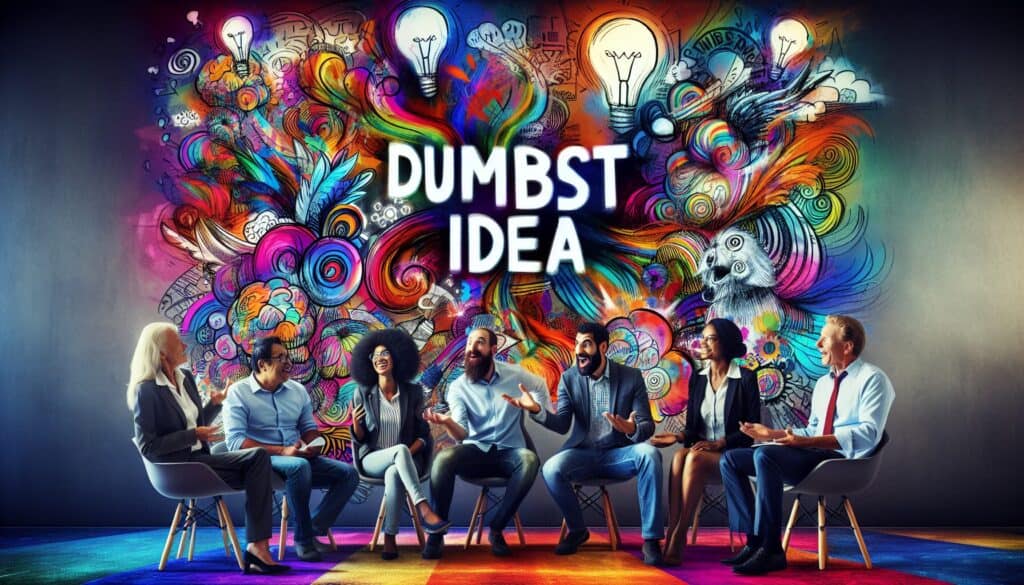Una técnica de brainstorming en la que los participantes generan intencionadamente ideas poco prácticas, absurdas o "tontas" como forma de relajarse, romper barreras creativas y despertar un pensamiento más innovador.
- Metodologías: Gestión de proyectos
La idea más tonta primero (la peor idea posible)

La idea más tonta primero (la peor idea posible)
- Metodología ágil, Lluvia de ideas, Mejora continua, Creatividad, Colaboración multifuncional, Pensamiento de diseño, Ideación, Innovación, Técnicas de resolución de problemas
Objetivo:
Cómo se utiliza:
- El grupo se centra en encontrar las peores soluciones o las más inviables para un problema. Estas malas ideas pueden invertirse o utilizarse como trampolín hacia las buenas ideas.
Ventajas
- Reduce el miedo a ser juzgado y fomenta la participación; puede inyectar humor y energía a la sesión; las malas ideas a menudo pueden suscitar ideas realmente buenas y poco convencionales al cuestionar los supuestos.
Contras
- Puede ser percibido como una pérdida de tiempo por algunos si no se facilita bien; requiere un cambio de mentalidad para ver el valor de las "malas" ideas; necesita un proceso de seguimiento para transformar o construir sobre estas ideas.
Categorías:
- Ideación
Ideal para:
- Superar los bloqueos creativos y fomentar un entorno de ideación más abierto empezando con ideas intencionadamente malas.
This methodology is particularly applicable in industries such as software development, consumer electronics, and product innovation, where creative solutions are fundamental to success. During brainstorming sessions, teams can shift the focus from conventional thinking to deliberately absurd concepts, facilitating a more relaxed atmosphere that diminishes the fear of criticism. Participants typically include cross-functional team members, such as designers, engineers, marketing experts, and end-users, who bring diverse perspectives that can enhance the depth of ideation. This approach can be particularly useful in the early phases of project development, where clarifying goals and challenges is crucial. For instance, a team tasked with developing a new app might initially list out the most impractical features or functionalities, using these “worst ideas” to dissect what wouldn’t work and why, thereby illuminating viable options and promoting creative breakthroughs. This technique is often employed alongside other ideation processes, such as design thinking or agile methodologies, enriching the creative pipeline by challenging existing assumptions and pushing the boundaries of what is considered feasible. Organizations like IDEO have utilized similar tactics to invigorate their design processes, and tech companies often harness this method during innovation workshops to catalyze evolución del producto. These sessions can inject humor and energy, transforming problem-solving into an engaging and collaborative endeavor, reinforcing team dynamics while generating unexpected insights that can form the basis for robust design solutions.
Pasos clave de esta metodología
- Define the problem or challenge clearly.
- Encourage participants to generate the worst possible ideas without filtering.
- Document all bad ideas without judgment.
- Analyze the bad ideas for underlying assumptions and thought patterns.
- Identify elements from the bad ideas that can be reversed or improved.
- Develop new ideas by transforming the worst ideas into potential solutions.
- Evaluate the new ideas for feasibility and potential effectiveness.
Consejos profesionales
- Encourage teams to adopt absurd personas or roles; this can shift their thinking and reveal unexpected angles.
- Incorporate timed bursts of idea generation for worst ideas; time pressure can lead to more bizarre and unfiltered suggestions.
- Facilitate a “reverse pitch” where team members argue why a bad idea could work; this forces deeper analysis and can reveal hidden merits.
Leer y comparar varias metodologías, recomendamos el
> Amplio repositorio de metodologías <
junto con otras más de 400 metodologías.
Sus comentarios sobre esta metodología o información adicional son bienvenidos en la dirección sección de comentarios ↓ , así como cualquier idea o enlace relacionado con la ingeniería.
Contexto histórico
1949
1950
1950
1960
1960
1960
1960
1940
1950
1950
1958
1960
1960
1960
1960
(si se desconoce la fecha o no es relevante, por ejemplo "mecánica de fluidos", se ofrece una estimación redondeada de su notable aparición)















Publicaciones relacionadas
Cuestionarios sobre molestias musculoesqueléticas
Pruebas multivariantes (MVT)
Análisis de regresión múltiple
Sistemas de captura de movimiento
Método MoSCoW
Prueba de la mediana de Mood